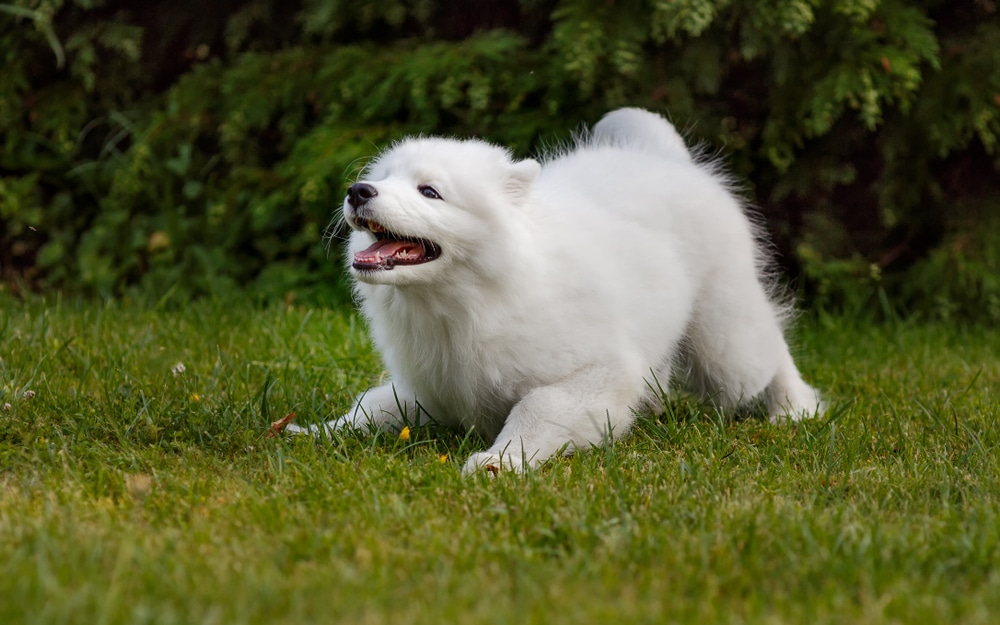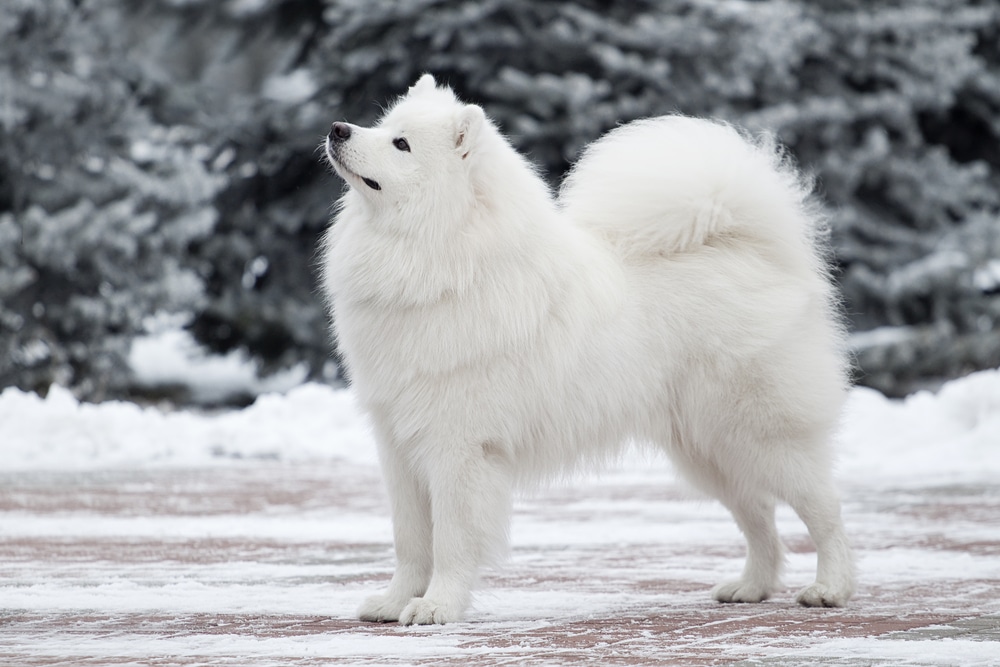Samoyeds, also known as ‘‘Sammies,’’ are quite popular because of their unique attributes. They have a fluffy white coat, a characteristic smile, and an independent yet friendly nature. Are those the only characteristics that make Samoyeds unique though?
Samoyeds are a famous breed known for their thick white double coats, ability to withstand hot and cold temperatures, natural smiling face, playful energy, and friendliness.
Table of Contents
- Origin Of Samoyeds
- Breed Characteristics Of Samoyeds
- Is Samoyed Among Those Breeds That Are Genetically Related To Wolves?
- Features Of A Samoyed’s Body Coat
- How Do Samoyeds Withstand Such Extreme Weather Conditions?
- A Perpetual Smile Having A Practical Function
- The Independent And Friendly Nature Of Samoyeds
- Do Samoyeds Get Bored Easily?
- Samoyeds As Working Dogs
- Conclusion: What Makes Samoyeds Unique?
Origin Of Samoyeds
Samoyeds are a medium-sized spitz-type breed of dog that originated in Siberia. In the early 19th century, this dog was bred by the nomads of Siberia for the purpose of herding, sled pulling, and hunting. Samoyeds descended from a spitz-type breed called Nenets herding Laika.
Samoyeds took their name from the Samoyedic nomads, also called Nenets. Genomic studies suggest that Samoyeds are a basal breed, which existed before modern breeds.
Breed Characteristics Of Samoyeds

Here’s what makes the Samoyed breed unique:
- A Samoyed is an intelligent, highly active, and independent yet friendly dog.
- A Samoyed has a compact, muscular body, a wedge-shaped head with triangular ears that are a bit round at the edge, and a fluffy tail that is arched when the dog is alert.
- Samoyeds have a double-layer coat that helps them adapt to hot and cold temperatures.
- A Samoyed coat that can be of white, cream, biscuit, white, and biscuit colors.
Samoyeds are a bit tricky to train because of their independent nature, and they need early socialization and obedience training to grasp commands. Samoyeds are also high-energy dogs with high prey drives. Therefore, they need ample space, playtime, and regular exercise.
Moreover, Samoyeds are very friendly with children, which makes them ideal family dogs. Also, a Samoyed’s long coat needs regular grooming sessions to keep the coat healthy. Samoyeds have a natural smiling face that has given it nicknames like “Smilin’ Sammie.’’ This feature also prevents excessive drooling.
Is Samoyed Among Those Breeds That Are Genetically Related To Wolves?
We all know dogs evolved from wolves. According to a theory, some of the amicable wolves started living close to the camp settlements of hunter-gatherer societies. The interbreeding of those wolves led to the emergence of modern-day dogs that evolved from the grey wolf (Canis Lupus).
All dogs share some degree of genetic lineage with wolves. However, some ancient dogs like Samoyeds and Huskies have more genetic similarities with wolves.
In general, Samoyeds are an ancient breed. They were bred by ancient nomads to perform various tasks for them, such as herding reindeer.
The nordic spitz group, including Samoyeds, Siberian Huskies, and Malamutes, has a higher degree of similarities with wolves compared to other breeds. You can learn more about this linkage and the evolution of dogs from wolves in this study.
Features Of A Samoyed’s Body Coat
Samoyeds are famous for their body coats, which are made of two layers of coats: the thick outer coat and the soft inner coat.
The outer coat is made of long coarse hairs that protect the undercoat from dirt and debris. The inner coat is made of soft, dense, short hairs that keep the body warm.
The undercoat sheds heavily once or twice a year, called seasonal shedding and also referred to as “blowing coat.” The undercoat also provides insulation, whereas the outer coat reflects the harmful sun rays and prevents them from penetrating into the inner coat. In this way, a Samoyed can also survive in hot weather conditions.
How Do Samoyeds Withstand Such Extreme Weather Conditions?
Samoyeds are a breed of Siberia, Russia, and thrive in the extreme cold of the Arctic region. The average temperature in Siberia is around minus 15 to minus 25 degrees celsius and can even reach minus 60 degrees. In such harsh climatic conditions, the double coat of Samoyed aids in conserving the heat produced by high physical activity.
The vasoconstriction (narrowing of the blood vessels) of the extremities reduces the loss of heat as well. Moreover, body heat gets trapped by the dense undercoat, keeping a Samoyed well insulated. The nomads used to cuddle Samoyeds to keep warm throughout the cold nights.
A Perpetual Smile Having A Practical Function
Apart from a fluffy double coat, Samoyeds are famous for their natural smiling face. They have a perpetual smile because the lips are naturally turned upwards from the corners.
Not only does this look beautiful, but the smile has a practical function as well: the natural curve prevents drooling by trapping the saliva. This avoids the build-up of ice crystals that may have formed if the saliva had dripped on the face and got frozen in low temperatures.
This feature also eliminates the hassle of cleaning up all the saliva that smears the coat of other breeds.
The Independent And Friendly Nature Of Samoyeds
Samoyeds are known for being super friendly with people, especially children. They have an independent nature, owing to their genomic resemblance with wolves. However, with socialization and training, one can raise a Samoyed to become a wonderful family pet.
Also, Samoyeds get along well with other dogs. Digging soil can be a problem though, as they are cold-loving breeds and may dig to reach a cold surface. Moreover, they have a high prey drive and may tend to chase and nip.
Do Samoyeds Get Bored Easily?
If you are planning to own a Samoyed, make sure you have plenty of space for physical activity and ample time to spend with your pet.
Samoyeds are highly energetic dogs and therefore need a lot of exercise and playful activities like jumping obstacles, fetching toys, etc. They may get bored easily, bark, and may destroy household objects in an attempt to deal with boredom too.
Samoyeds As Working Dogs
Another unique characteristic of Samoyeds is their ability to perform various tasks. The Nenets of Siberia used Samoyeds for sled pulling, herding reindeer, and hunting.
Samoyeds used to pull sleds on icy trails for long distances. They can pull more than 10 times their own weight too. Samoyeds have performed as sled dogs for years, exhibiting their prowess in pulling sleds in races.
Samoyeds possess a high prey drive, a muscular build, and the agility to chase prey for miles. Lastly, Samoyeds are excellent herding dogs.
Conclusion: What Makes Samoyeds Unique?
So, there are plenty of characteristics that make Samoyeds unique. Overall, they’re an incredible dog breed that has and will continue to bring joy to many humans around the world.
So, are you looking to get a Samoyed, or were you just curious about them? Let us know what’s got you thinking about what makes Samoyeds unique in the comments below!
